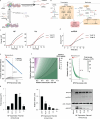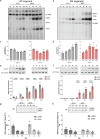This is a preprint.
Febrile temperature activates the innate immune response by promoting aberrant influenza A virus RNA synthesis
- PMID: 40475563
- PMCID: PMC12139806
- DOI: 10.1101/2025.05.19.654939
Febrile temperature activates the innate immune response by promoting aberrant influenza A virus RNA synthesis
Abstract
Fever during influenza A virus (IAV) infection is triggered by the innate immune response. Various factors contribute to this response, including IAV mini viral RNAs (mvRNA), which trigger RIG-I signaling when their replication and transcription are dysregulated by template loops (t-loop). It is presently not well understood whether the fever response to IAV infection impacts subsequent viral replication and innate immune activation. Here we show that IAV infection at temperatures that simulate fever leads to increased antiviral signaling in H1N1 and H3N2 infections. Mathematical modeling and experimental analyses reveal that differential IAV nucleoprotein and RNA polymerase production increase mvRNA and interferon production. Moreover, at the higher infection temperature, mvRNAs with dysregulating t-loops contribute most to the innate immune activation. We propose that fever during IAV infection can establish a positive feedback loop in which elevated aberrant RNA synthesis and innate immune activation can contribute to the dysregulation of cytokine production.
Keywords: RIG-I; RNA polymerase; capped cRNA; fever; influenza A virus; interferon; mini viral RNA; mvRNA; temperature; template loop.
Conflict of interest statement
Competing interests The authors declare no competing interests.
Figures





Similar articles
-
A two-step mechanism for RIG-I activation by influenza virus mvRNAs.Sci Adv. 2025 Aug 8;11(32):eadw8034. doi: 10.1126/sciadv.adw8034. Epub 2025 Aug 8. Sci Adv. 2025. PMID: 40779639 Free PMC article.
-
IncRNA IPAN antagonizes RIG-I/TRIM25-mediated degradation of influenza A virus PB1 to promote viral replication.Biosaf Health. 2025 May 17;7(3):199-208. doi: 10.1016/j.bsheal.2025.05.005. eCollection 2025 Jun. Biosaf Health. 2025. PMID: 40693041 Free PMC article.
-
RIG-I agonist SLR10 promotes macrophage M1 polarization during influenza virus infection.Front Immunol. 2023 Jul 5;14:1177624. doi: 10.3389/fimmu.2023.1177624. eCollection 2023. Front Immunol. 2023. PMID: 37475869 Free PMC article.
-
Innate immune role of IL-6 in influenza a virus pathogenesis.Front Cell Infect Microbiol. 2025 Jul 7;15:1605446. doi: 10.3389/fcimb.2025.1605446. eCollection 2025. Front Cell Infect Microbiol. 2025. PMID: 40692679 Free PMC article. Review.
-
The global burden of swine influenza and its mitigation.Open Vet J. 2025 May;15(5):1866-1879. doi: 10.5455/OVJ.2025.v15.i5.3. Epub 2025 May 31. Open Vet J. 2025. PMID: 40557091 Free PMC article. Review.
References
Publication types
Grants and funding
LinkOut - more resources
Full Text Sources
